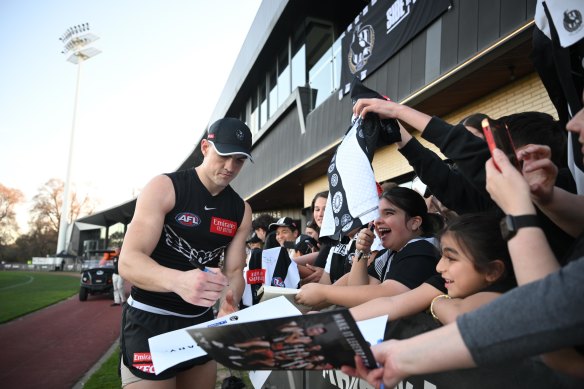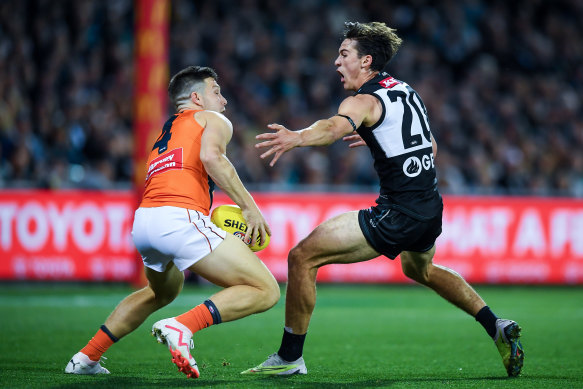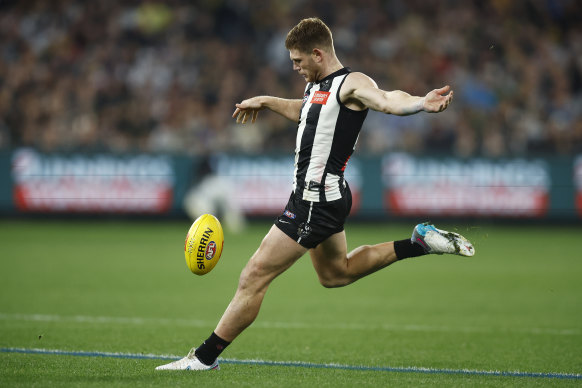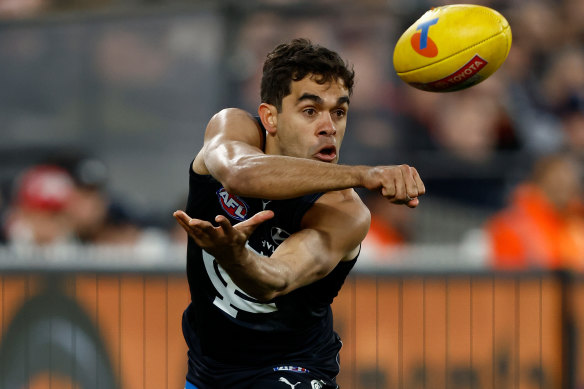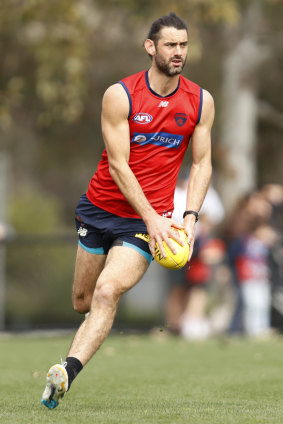Four Points: Maynard and Greene, a battle to savour; Blue’s pay day; and the Barassi boots
Save articles for later
Add articles to your saved list and come back to them any time.
In the most remarkable of transformations, Toby Greene’s likely opponent is presently a bigger villain than he is. The oft-reported provocateur turned All-Australian captain will likely be opposed by Brayden Maynard, the player on whom more column inches have been spent than on the Giants’ whole season.
Some remain troubled Maynard is playing at all, others wonder what all the fuss was about?
Brayden Maynard with Collingwood fans at training on Friday.Credit: Eddie Jim
Maynard should stand Greene, the most dangerous man in the final if not the finals series.
Maynard has a bit of Toby Greene about him, if not the length or diversity of his tribunal rap sheet, then the full throttle way he plays. Maynard was a rough-hewn De La Salle boy, Greene’s dad was a De La Old Coll’s legend. Despite Greene not going to the school, his family name is synonymous with De La footy’s golden age.
Greene didn’t play when the Giants upset Collingwood in the preliminary final of 2019. He didn’t play earlier this year when the Giants were belted. But in 2021 in an eight-minute burst in round four, Greene kicked three goals and made Isaac Quaynor look like a schoolboy.
Quaynor was humbled by Greene, not the first player to suffer that sort of drubbing, and had to be moved off him. Greene kicked another two before Maynard was moved onto him and he didn’t get another for the day.
“It was something I was excited to be part of, to see how I would go against one of the best forwards, if not the best, forward in the comp and I didn’t go great,” Quaynor told The Age’s Peter Ryan last year.
“There were a lot of learnings to take out of it … that was a big ego hit.”
Maynard was the reliable fallback that day because he had beaten Greene soundly before, in the 2018 semi-final when he kept the little Giant goalless in a game that solidified Maynard’s place in the bosom of Magpies fans.
Toby Greene competes with Port Adelaide’s Connor Rozee on Saturday.Credit: Getty Images
Nathan Buckley’s choice of Quaynor was about schooling him in playing on the best forward of his size in the AFL. Quaynor learnt much and is a vastly better player now than he was then, as shown by his nerveless performance in the last quarter of the qualifying final win over Melbourne, but Maynard should be the first choice not the fallback.
That decision remains with Collingwood. The other most critical decision – who goes out for Nick Daicos to come in – has been taken out of their hands. Taylor Adams’ hamstring injury makes for an obvious one-out, one-in.
Adams’ out is highly significant for Collingwood. Yes, some would say it addresses a question of the pace of the midfield, especially now coming up against the run of GWS, but it removes a critical element of their strength and aggression around the ball.
Taylor Adams will be missed by the Magpies.Credit: Getty Images
Adams has been an important finals player over years at Collingwood. He will frustrate with his overly ambitious choices of kicks but his aggression and heat around the ball is crucial.
Against GWS that level of pressure and heat is essential to have a chance of stopping their run. Against the Giants, Adams’ absence will hurt.
GWS have been playing wonderfully complete football. They are big bodied, tough, have stars on every line and a perfectly rounded midfield of one-touch contested-ball beasts and light-footed runners who use the ball with the art of a painter.
But they have also been allowed to play the way they want by two teams that applied little to no pressure, in St Kilda’s case, and only sporadic pressure in Port’s case. Port have too many one-way runners and only for stages of the first and third quarters did they bring any heat to the Giants.
Collingwood is a good pressure team and Adams leads that from the bounce. In a game like this Adams’ absence will be felt.
Blue’s pay day
Jack Martin was paid a million dollars by Carlton in his first year, but he has never come close to actually earning that sort of money.
His five-year contract at Carlton averaged out well below the seven-figure mark – at roughly $650,000 a year – but the method of safeguarding his free passage through the pre-season draft was to heavily front-end that contract.
Jack Martin in action against Sydney in the first elimination final.Credit: AFL Photos
He safely arrived at Carlton but has never looked like the player the Blues hoped he would be. Until now.
Martin was outstanding against Sydney, save for his report and one-game suspension. He owes his team for that.
It was one of his best and certainly the most consequential game he has played for Carlton. He looks like a finals player.
He is the type of elite talent who rises to higher-quality games. He is lifted by the crowd and the moment and the intensity and pace of finals. He is a cream player, not one who does well in a middling side. The better Carlton have become, the better Martin is. He adds an important dimension to Carlton’s attack.
Brodie Grundy.Credit: Getty Images
No Schache in attack
The selection of Josh Schache as Melbourne’s sub was surprising before the game and just bizarre afterwards.
The non-selection of Brodie Grundy was unsurprising given a line had already been put through his name as a forward, but to choose Schache over him and then not put him on the ground against Carlton was quite weird.
Firstly, Schache is few people’s idea of the answer. But he was the Plan B answer in Melbourne’s match committee last week.
That they never introduced a player they had decided in the week’s planning would be their contingency if they failed to find a target nor kick a winning score is mystifying.
Yes, with a minute to go Melbourne were leading and could have – should have – been able to hang on from that moment to win. But they didn’t.
They didn’t because they fluffed too many moments – Max Gawn touching a ball on the goal line that would have gone through for a goal, Jack Viney chipping the ball straight to Jacob Weitering for the turnover that created the Blakes Acres winning goal – but mainly for the missed shots and dunderheaded wasted forward entries. They could not reliably convert and kick a score, and yet they left the player they had figured to be their Hail Mary option sitting in a tracksuit.
To be clear, I don’t think Schache would have been close to the difference. But someone at Melbourne during the week thought he could have been the difference and yet when it came to it they didn’t try it.
That they didn’t trust bringing him on also meant they denied themselves the choice of bringing in a running player in the second half and injecting pace late in the game. Carlton benefited from Ollie Hollands coming on the ground as sub. He added run and pressure – he was involved in the critical final game-deciding play – but Melbourne added nothing and no one.
Melbourne started Friday’s game intent on keeping their eyes down, their choices in attack close and their kicking short. But as the game wore and tiredness set in, they just fell to kicking long.
They played straight-line, unadventurous football, routinely lobbing a ball to outnumbered, outsized or outclassed forwards and expecting a different result each time they did so. It was only late that they tried to isolate Kozzy Pickett in the goal square and for the first time they worried Carlton’s defence.
What was also perplexing was why Christian Petracca was not in the centre square for the final bounce. Once Carlton kicked their last-minute goal to take the lead, Melbourne had 56 seconds to try to score. They needed the centre clearance, Carlton needed only to lock it up. And yet Petracca, their most dangerous clearance player, was not in at the bounce.
In your Ron Barassis
Don’t let it get lost in the many, many virtuous tributes of the peerless contribution of Ron Barassi to the game that his name was not only synonymous with the game itself, but with the boots players wore.
Footballers of a certain age, right through until the seventies, didn’t wear footy boots. They wore Ron Barassis. High cut, long stops, and black. Always black. They were as comfortable as gumboots with no socks. And he became the best player many have seen wearing them.
Keep up to date with the best AFL coverage in the country. Sign up for the Real Footy newsletter.
Most Viewed in Sport
From our partners
Source: Read Full Article

